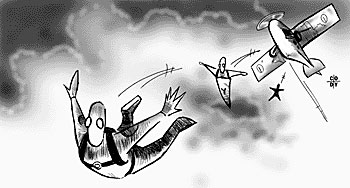
Illustration by Cody Angell
|
By Paul Iiams
Arizona Daily Wildcat
Thursday December 5, 2002
As you look at your list of things to do before you die, you start to think about opportunities missed. All the "nevers" can bring you down in a hurry.
You never got a chance to kiss the pretty girl or the hunky guy, you never streaked at a sporting event, and you never hurled yourself out of an airplane.
But take heart, O wounded one. Even though the object of your desire doesn't know you exist, and showing the world your goods doesn't seem as appealing anymore, you can still cross one to-do off your life's list.
Skydiving is quickly becoming a popular and readily available activity for people of all ages. It is especially attractive to college-age students.
Falling out of the sky at a possible 150 miles per hour can be a frightening thing. In an effort to help calm each other's nerves, groups of people make the journey together. Several students living in Yuma Residence Hall got together to make this journey.
"Seven people (from the hall) went," said David Sonenschein, an engineering sophomore. "This is the first time, to my knowledge, the hall has gone skydiving as a group."
Sonenschein, Yuma's Residence Hall Association representative and a member of RHA's services committee, said that 12 people originally had signed up to go, but economics and politics became limiting factors.
"Yuma requested $300 to pay for an estimated 15 people," he said. "The services committee actually approved allocating $500, but the request was rejected at the following general body meeting of RHA."
That wasn't the end of the financial barriers the people of Yuma faced, either.
"In addition, Yuma Hall Government was going to contribute $150, but (Residence Life) told Doug (Copeland, Yuma's hall director) there could be liability issues with the school giving money to support such a risky activity, and that we would either have to postpone the trip, or not use hall government money," he said. "We chose the latter."
Copeland had a feeling that the funding was going to be an issue.
"We basically knew from the beginning not to expect it," he said. "We were not counting on it."
The four who cancelled, according to Sonenschein, did so due to financial issues.
Businesses like the Marana Skydiving Center in Marana and Skydive Arizona in Eloy recognize the growing trend of student group jumping and are giving discounts, accordingly. Marana offers tandem jumps for students at $109. They also give a discount for groups of three or more. Skydive Arizona gives discounts for students and people who pay cash.
Why skydiving? Is it the rush of falling 5,000 feet before pulling a little cord that keeps you from becoming road kill? Is it the millisecond of doubt that sets in while you are pulling on the cord? Sonenschein thinks it's much simpler.
"Beats doing homework on a Saturday morning," he said, half-jokingly.
The rush of free-falling and the ability to get out of homework still aren't enough for some people.
"Not for all the riches on earth, heaven and hell," history junior Derrick Palmer said. "I'd rather not fly anywhere, especially when my only propeller is a parachute."
Palmer went on to say that he liked his feet being on the ground, not "sunk 5 feet in after landing."
Part of Palmer's trepidation about skydiving may be inexperience. But everyone who skydives originally had that first jump. And when they did, there was someone with them.
Inexperienced jumpers are teamed with an instructor in what is called a tandem jump. The instructor is licensed and bonded and has vast experience jumping out of airplanes at upward of 10,000 feet.
The instructor will first teach you the basics of skydiving. You are then strapped in front of the instructor and sent flying. You are usually in control of pulling the cord, but the instructor is there, just in case.
After the first jump, you would think that every jump afterward would be a piece of cake. Not so, says Sonenschein, who was skydiving for the second time ever.
"I did feel more nervous than I did last time," he said. "I guess it just sunk in more. You know, the ╬Holy-crap-I'm-jumping-out-of-an-airplane!' thing."
All nerves aside, Sonenschein thinks the group had a good time.
"We've talked about trying to do this once a semester," he said.
Just remember to pull the rip cord.

